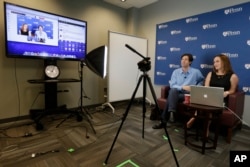There are more than 4,000 colleges and universities in the United States, where the educational experience traditionally revolves around living on campus and attending classes in person.
However, now, with the help of technology, the way knowledge passes from teachers to their students is changing.
In February 2016, the Babson Survey Research Group reported that 28 percent of all U.S. college students took at least one class over the internet. The research group, part of Babson College in Massachusetts, studies all levels of education across the country.
Yet, having students take a few online classes during their college years is not the only change technology is driving.
Many U.S. colleges and universities now offer full degree programs online. This opens up all kinds of possibilities for students around the world.
New educational possibilities
One such student, Leanne from Cherry Hill, New Jersey, is using an online degree program to meet her needs. The 30-year-old asked VOA not to share her last name as she has yet to complete her studies.
In 2012, Leanne earned a bachelor’s degree in nursing through a traditional study program at Thomas Jefferson University in Philadelphia. She then started working as a nurse in the Washington, D.C. area.
After a few years, Leanne decided she wanted to earn a master’s degree to help further her career in medicine. However, she did not want to move to another city to continue her education, as can often be the case for students. Her job and her husband were in Washington, and she only wanted to study part-time. So, Leanne decided to look for an online program.
"There were a lot of good, appealing things about doing it online," she said. "It allowed me to work full-time and fit the schoolwork into my schedule, which often made it a lot more financially feasible."
In 2014, Leanne began taking nursing classes through the online master’s degree program at DC’s George Washington University. The program provides medical training videos through her home computer. She also is involved in discussion groups, takes tests, and submits projects online.
Leanne says much of her studies are self-directed. But students also must physically visit the university at least four times during their three-year program for in-person testing.
Leanne says her program appeals to a lot of people with full-time jobs. And, George Washington University is not alone in its efforts to spread online education.
Overcoming barriers
The communications company AT&T gave the Georgia Institute of Technology $4 million to create an online degree program in 2014. This led to an online master’s degree program in computer science.
And in the past few years, the program has become a true success story, says Joshua Goodman, an associate professor of public policy at Harvard University. Goodman studied the effects of the online program. Harvard’s Kennedy School of Government published his findings last September.
Goodman says online degree programs have faced two major barriers. First, it has often been lesser-known, lower-quality, or for-profit universities that have offered online programs. Second, well-known, high-quality schools charged the same price for online and in-person programs, which often led to students choosing the traditional programs.
But the Georgia Tech program may have solved these problems, Goodman says. Many experts consider the university to have one of the best computer science master’s degree programs in the country. Also, Georgia Tech began offering the online program at less than one-sixth of the cost of the traditional program.
The school’s in-person program only has room for about 300 students. The online program had about 1,700 new students at the start of the school year.
Goodman argues it's not just the quality or the price that make Georgia Tech’s online program so successful. The average age of students trying to get into the traditional program is about 24. The average age of the online students is 34. These are people in the middle of their careers, Goodman notes. They are not free to drop everything and spend a few years studying instead of working.
Goodman says before the Georgia Tech program, many of these people had no other good choices for furthering their education.
"The folks who applied for this program … did not have other educational options that they would do if they didn’t get into this program," he said. "What we found is that if they got into this program, they went, they did this degree. And if they didn’t get in, almost none of them went to another university. So it seems like this program is creating educational opportunities for mid-career people that would not have otherwise existed."
Financial boost for struggling colleges
Online degree programs seem to not only help students with non-traditional needs. In some cases, the appeal of the programs has helped the schools themselves. This is especially important considering many colleges and universities have struggled financially in recent years.
Simmons College is a small, private college in Boston, Massachusetts. For several years, Simmons accepted more graduate students than undergraduates. In 2012, the school created a plan to start offering two of its most popular master’s degree programs online. The two are in nursing and social work.
Last year, the college collected about $45 million in student payments for those programs. This year the programs are expected to bring in about $55.9 million. This is about $3 million more than all the in-person graduate programs Simmons offers, combined.
Suzanne Murphy, head of the online programs at Simmons, says the reason those programs appeal to so many students is the quality.
“You measure success in student outcomes,” Murphy said. “‘How are the students doing?’ ‘How are they progressing through the programs?’ Things like that. And the programs that we put online are the same programs that we have on the ground.”










